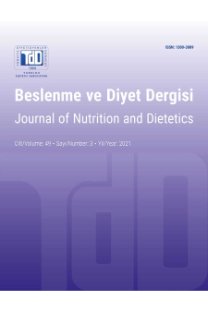İnflamatuvar Barsak Hastalığı Olan Çocuklarda Malnütrisyon ve Beslenme Durumunun Değerlendirilmesi
An Evaluation of Malnutrition and Nutritional Status of Children with Inflammatory Bowel Disease
___
- 1. Kliegman R, Nelson WE. Nelson Textbook of Pediatrics. 18th ed. Philadelphia: Saunders Publishing;2007.
- 2. Mahan LK, Escott-Stump S. Krause's Food, Nutrition, & Diet Therapy. 10th ed. Philadelphia: WB Saunders Publishing; 2000.
- 3. Cosnes J, Gower-Rousseau C, Seksik P, Cortot A. Epidemiology and natural history of inflammatory bowel diseases. Gastroenterology 2011;140(6):1785- 1794.
- 4. Logan I, Bowlus CL. The geoepidemiology of autoimmune intestinal diseases. Autoimmun Rev 2010;9 (5):A372-378.
- 5. Tozun N, Atug O, Imeryuz N, Hamzaoglu, HO, Tiftikci A, Parlak E, et al. Clinical characteristics of inflammatory bowel disease in Turkey: a multicenter epidemiologic survey. J Clin Gastroenterol 2009;43(1):51-57.
- 6. Walker WA. Pediatric gastrointestinal disease: pathophysiology, diagnosis, management 5rd ed. Hamilton Ont; BC Decker Publishing; 2008.
- 7. Massironi S, Rossi RE, Cavalcoli FA, Della Valle S, Fraquelli M, Conte D. Nutritional deficiencies in inflammatory bowel disease: therapeutic approaches. Clin Nutr 2013;32(6):904-910.
- 8. Hartman C, Eliakim R, Shamir R. Nutritional status and nutritional therapy in inflammatory bowel diseases. World J Gastroenterol 2009;15(21):2570-2578.
- 9. Kugathasan S, Nebel J, Skelton JA, Markowitz J, Keljo D, Rosh J, et al. Body mass index in children with newly diagnosed inflammatory bowel disease: observations from two multicenter North American inception cohorts. J Pediatr 2007;151(5):523-527.
- 10. Griffiths AM. Growth retardation in early-onset inflammatory bowel disease: should we monitor and treat these patients differently? Dig Dis 2009;27(3):404- 411.
- 11. Heuschkel R, Salvestrini C, Beattie RM, Hildebrand H, Walters T, Griffiths A. Guidelines for the management of growth failure in childhood inflammatory bowel disease. Inflamm Bowel Dis 2008;14(6):839-849.
- 12. Conklin LS, Oliva-Hemker M. Nutritional considerations in pediatric inflammatory bowel disease. Expert Rev Gastroenterol Hepatol 2010;4(3):305-317.
- 13. Geissler C, Powers HJ, Garrow JS. Human Nutrition. 11th ed. Edinburgh, New York: Elsevier/Churchill Livingstone Publishing; 2005.
- 14. Hyams JS, Ferry GD, Mandel FS, Gryboski JD, Kibort PM, Kirschner BS, et al. Development and validation of a pediatric Crohn's disease activity index. J Pediatr Gastroenterol Nutr 1991;12(4):439-447.
- 15. Turner D, Otley AR, Mack D, Hyams J, De Bruijne J, Uusoue K. et al. Development, validation, and evaluation of a pediatric ulcerative colitis activity index: a prospective multicenter study. Gastroenterology 2007;133(2):423-432.
- 16. WHO AnthroPlus. Geneva. 2009. Available at: http:// www. who. int/growthref/ tools / en/.
- 17. Pekcan G. Beslenme Durumunun Saptanması (Eds: Baysal A, Aksoy M, Besler T, Bozkurt N, Keçecioğlu S, Kutluay Merdol T ve arkadaşları). Diyet El Kitabı. 11. Baskı. Hatiboğlu Basın ve Yayım San. Tic. Ltd. Şti, Ankara, 2011, s. 67-142.
- 18. Magkos F, Manios Y, Babaroutsi E, Sidossis LS. Development and validation of a food frequency questionnaire for assessing dietary calcium intake in the general population. Osteoporos Int 2006;17(2):304- 312.
- 19. Bebis für windows; Turkish version (BeBis 6.1). Program uses data from Bundeslebenmitte Ischlüssel (BLS) 11.3 and USDA 15. (2007). Sturttgart, Germany.
- 20. T.C. Sağlık Bakanlığı, Obezite, Diyabet ve Metabolik Hastalıklar Daire Başkanlığı, Türkiye'ye Özgü Beslenme Rehberi. Erişim:http://beslenme.gov. tr/content/files /yayinlar/kitaplar/diger_kitaplar/ beslenme_rehberi.pdf, 2004.
- 21. Alpar R. Spor, Sağlık ve Eğitim Bilimlerinden Örneklerle Uygulamalı İstatistik ve Geçerlik-Güvenirlik. 3. Baskı. Detay Yayıncılık Ankara, 2010.
- 22. Kohlstadt I. Food and Nutrients in Disease Management. 1st ed. Boca Raton; CRC Press; 2009.
- 23. Lee JJ, Escher JC, Shuman MJ, Forbes PW, Delemarre LC, Harr BW, et al. Final adult height of children with inflammatory bowel disease is predicted by parental height and patient minimum height Z-score. Inflamm Bowel Dis 2010;16(10):1669-1677.
- 24. Ezri J, Marques-Vidal P, Nydegger A. Impact of disease and treatments on growth and puberty of pediatric patients with inflammatory bowel disease. Digestion 2012;85(4):308-319.
- 25. Pons R, Whitten KE, Woodhead H, Leach ST, Lemberg DA, Day AS. Dietary intakes of children with Crohn's disease. Br J Nutr 2009;102(7):1052-1057.
- 26. Zopf Y, Rabe C, Kollmann S, Hahn EG, Thurauf N, Schwab D. Alterations of taste perception in Crohn's disease and their dependency on disease activity and nutritional behavior. J Clin Gastroenterol 2009;43(7):617-621.
- 27. Steinbach S, Reindl W, Dempfle A, Schuster A, Wolf P, Hundt W, et al. Smell and taste in inflammatory bowel disease. PLoS One 2013;8(9):e73454.
- 28. Geerling BJ, Badart-Smook A, Stockbrugger RW, Brummer RJ. Comprehensive nutritional status in recently diagnosed patients with inflammatory bowel disease compared with population controls. Eur J Clin Nutr 2000;54 (6): 514-521.
- 29. Lochs H, Dejong C, Hammarqvist F, Hebuterne X, Leon-Sanz M, Schutz T, et al. ESPEN Guidelines on Enteral Nutrition: Gastroenterology. Clin Nutr 2006;25(2):260-274.
- ISSN: 1300-3089
- Yayın Aralığı: 3
- Başlangıç: 1972
- Yayıncı: Türkiye Diyestisyenler Derneği
Tip 2 Diyabet Hastalarında Besin Gruplarının Diyetin Enerji ve Makro Besin Ögelerine Katkısı
Burcu AKSOY, ÖZGE KÜÇÜKERDÖNMEZ, Aydoğan AYDOĞDU, Gülhan SAMUR
Gebelik ve Laktasyon Döneminde İyodun Önemi
Burcu AKSOY, Fatma ILGAZ, Zehra Büyüktuncer DEMİREL, Hülya Gökmen ÖZEL
Konjenital Nefrotik Sendromlu Bir Olguda Ağır Hiperlipideminin Tıbbi Beslenme Tedavisi
Nevra KOÇ, Mehmet GÜNDÜZ, ÖZLEM ÜNAL, Aysel TAKTAK², Nida DİNÇEL
Kayseri'de Mobilya Üretiminde Çalışan İşçilerin Beslenme Durumu ve Alışkanlıklarının Belirlenmesi
GÜLŞAH KANER, Meltem SOYLU, Eda BAŞMISIRLI, Neriman İNANÇ
İnflamatuvar Barsak Hastalığı Olan Çocuklarda Malnütrisyon ve Beslenme Durumunun Değerlendirilmesi
Ceyda Tuğba PEKMEZ, Gülhan SAMUR, Yusuf AYDEMİR, Hasan ÖZEN, Aysel YÜCE
Mevlüde KIZIL, Nagham WASSOUF, M. Merve TENGİLİMOĞLU METİN, Damla GÜMÜŞ, DERYA DİKMEN, M. Fatih UYAR
Beslenme ve Diyetetik Eğitim Öğretiminin Standardizasyonu
Krill Yağı Desteği ve Yeni Bilimsel Kanıtlar
Kübra Tel ADIGÜZEL, KÜBRA IŞGIN, Gülden PEKCAN
